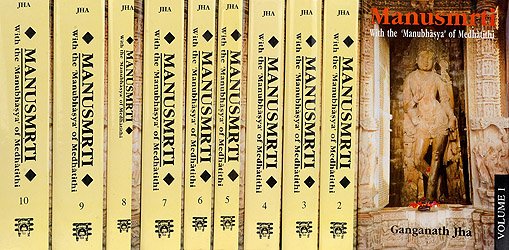Manusmriti with the Commentary of Medhatithi
by Ganganatha Jha | 1920 | 1,381,940 words | ISBN-10: 8120811550 | ISBN-13: 9788120811553
This is the English translation of the Manusmriti, which is a collection of Sanskrit verses dealing with ‘Dharma’, a collective name for human purpose, their duties and the law. Various topics will be dealt with, but this volume of the series includes 12 discourses (adhyaya). The commentary on this text by Medhatithi elaborately explains various t...
Verse 3.232
Sanskrit text, Unicode transliteration and English translation by Ganganath Jha:
स्वाध्यायं श्रावयेत् पित्र्ये धर्मशास्त्राणि चैव हि ।
आख्यानानीतिहासांश्च पुराणानि खिलानि च ॥ २३२ ॥svādhyāyaṃ śrāvayet pitrye dharmaśāstrāṇi caiva hi |
ākhyānānītihāsāṃśca purāṇāni khilāni ca || 232 ||At the rite in honour of the Pitṛs, one should recite the Vedic text, Legal Institutes, Stories, Histories, Legends and supplementary Texts.—(232)
Medhātithi’s commentary (manubhāṣya):
‘Svādhyāyaḥ’— Vedic Text.
‘Legal Institutes’—the works of Manu and others.
‘Stories’—such as those of Suparṇa, Mitrāvaruṇa, and the rest, related in the Ṛgveda.
‘Histories’—Mahābhārata, etc.
‘Legends’—describing the creation of the world and such other subjects, written by Vyāsa and others.
‘Supplementary texts’—e.g., the Śrī-sūkta, the Mahānāmnikā, and the like.—(232)
Explanatory notes by Ganganath Jha
‘Ākhyānāni’—‘Legends relating to Suparṇa, Mitrāvaruṇa and the rest, related in the Ṛgveda’ (Medhātithi, Govindarāja, Kullūka and Rāghavānanda);—‘such legends as occur in the Brāhmaṇas’ (Nārāyaṇa);—‘the legends relating to the death of Kaṃsa and so forth’ (Nandana).
This verse is quoted in Aparārka (p. 502);—in Gadādharapaddhati (Kāla, p. 560), which explains ‘Khilāni’ as standing for the ‘Harivaṃśa and the rest’;—in Śrāddhakriyākaumudī (p. 172), which explains ‘Dharmaśāstrāṇi’ as ‘Manu and the rest’, ‘ākhyānāni’ as ‘sauparṇa and the like,’ and ‘khilāni’ as ‘the Śivasaṅkalpa and other hymns—and in Hemādri (Śrāddha, p. 1069), which has the following notes;—‘Svādhyāyaḥ,’ Veda,—‘Dharmaśastraṇi,’ works compiled by Manu and others,—‘ākhyānāni,’ such stories contained in the Ṛgveda as the ‘Sauparṇa,’ the ‘Maitrāvaruṇa’ and the ‘Pāriplava,’ as also such Puranic stories as the one relating to the ‘Seven Fowlers,’—‘itihāsa’ stands for the Mahābhārata and such works,—‘Purāṇa’ for the compilations which deal with the five subjects of Creation, Dissolution, Genealogies, Age-cycles, Deeds of royal dynasties,—‘khilāni’ for the Strīsūkta, the Mahānāmnika and other hymns.
Comparative notes by various authors
Āśvalāyana Gṛhyasūtra (4.8.10).—‘Realising that they have become satisfied, he shall make them listen to the Madhumatī verses, as also the mantra ‘Dakṣannamīmadanta, etc.’
Viṣṇu (73.26).—‘Itihāsas, Purāṇas and Dharmaśāstras.’
Laghu-Āśvalāyana (23.66-67).—‘The hymns beginning with the words Nāsadāsit, etc., should be repeated before the Brāhmaṇas while they are eating; as also the hymn Kṛṇuṣva, etc., and also the Rakṣoghna mantras; the hymn beginning with Agnimīle should be recited in praise of the Pitṛs, as also other sacred hymns, all the time that the feeding of Brāhmaṇas goes on.’
Padmapurāṇa (Caturvarga-cintāmaṇi-Śrāddha, p. 1070).—‘At the rite in honour of Pitṛs, one shall have recited the Veda, the Purāṇas and the supplements, as also the hymns sacred to Brahmā, Viṣṇu, Arka and Rudra.’
Yama (Caturvarga-cintāmaṇi-Śrāddha, p. 1070).—‘The Veda should be recited, as also the Dharma-śāstras over and over again; he shall recite before them the several Itihāsas also.’
Pracetas (Caturvarga-cintāmaṇi-Śrāddha, p. 1070).—‘After the Brāhmaṇas have taken their food, he shall recite before them, the Ṛk, the Yajūṣ and the Sāman as also all that is sacred to the Pitṛs.’
Kātyāyana (Aparārka, p. 501).—‘While the Brāhmaṇas are eating, one shall repeat the Gāyatrī with the Praṇava and the Vyāhṛtis, once or thrice, as also the Rakṣoghna mantras, the Pitṛ-mantras, the Puruṣasūkta and other sacred texts.’
Baudhāyana (Aparārka, p. 502).—‘The Rakṣoghna Sāmas, the Yajuṣ texts with svadhā and the Madhu-ṛks—these should be recited to the eaters.’
Viṣṇupurāṇa (Aparārka, p. 502)—‘The reciting of the Rakṣoghna mantras.’
